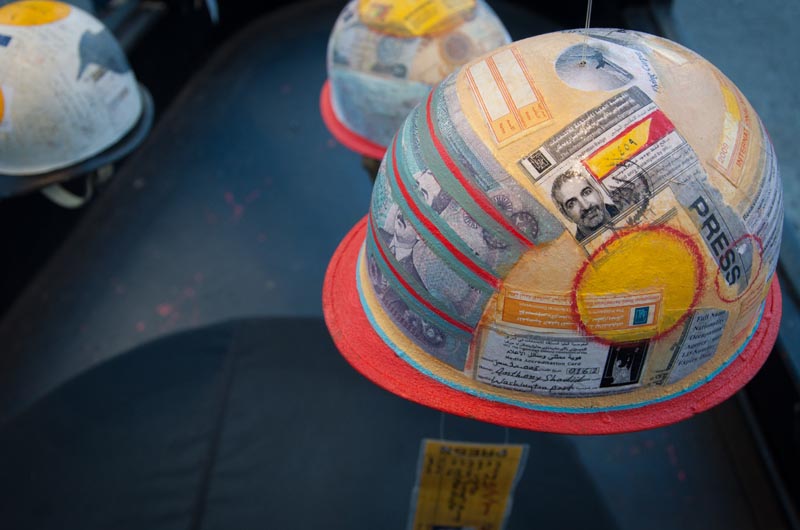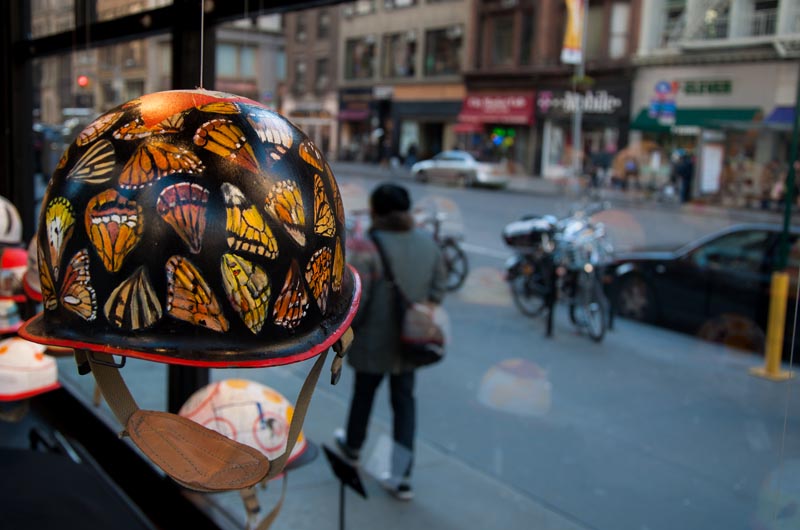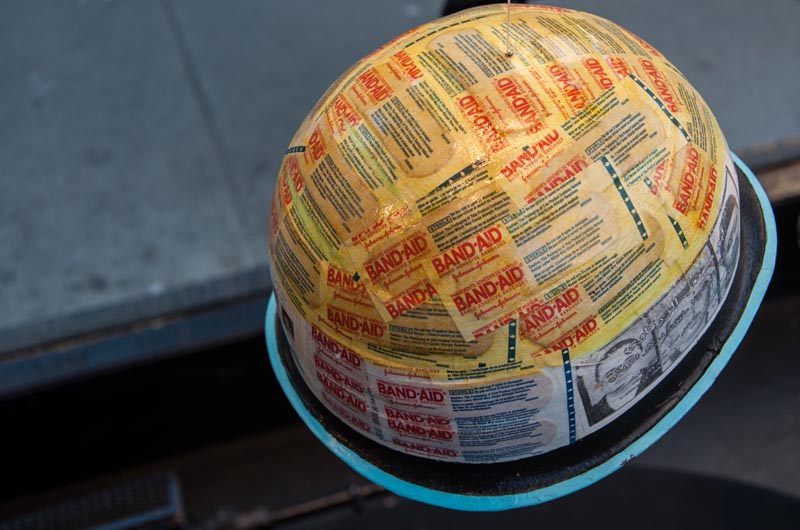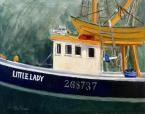Cindy Kane was helping her husband with an errand on Sunday morning when she heard that another human rights worker had been killed by Islamic militants. A video had just been released of the beheading of Peter Kassig, a 26-year-old American aid worker.
“It’s so tragic, it’s just devastating,” Ms. Kane said from her Vineyard Haven home. “I just got the news a few minutes ago.”
The news was especially poignant as she prepared for the latest incarnation of her art installation, Eyes on the Ground – Journals of War, to open at the Flatiron Building in New York city. Over the past 10 years, Ms. Kane has collected personal mementos and notes from foreign correspondents sent to cover embattled areas and wars across the world. Ms. Kane covered old metal Viet Nam era war helmets with the artifacts. There are 50 in total.
“I think that sadly, this tribute becomes more relevant as time goes on because the world is so much more of a dangerous place for journalists,” Ms. Kane said.
The exhibit premiered in 2008 at the former Carol Craven Gallery in Vineyard Haven. The show at the Flatiron Building, one of New York’s most iconic buildings that splits Broadway and Fifth avenue, has given the show “new life and new political relevance,” Ms. Kane said. The show opened on Tuesday, Nov. 18, and is dedicated to Anthony Shadid, a New York Times reporter who died in 2012 while covering the war in Syria.
Through a trail of introductions over the years, including the Vineyard’s Ward Just, Charlayne Hunter-Gault, Geraldine Brooks and Tony Horwitz, Ms. Kane cultivated a “sense of community between journalists.” Foreign correspondents sent in an array of personal effects: notes from the field, press passes, airplane tickets, old passport pages stamped with individual countries they had covered.
“It was very endearing,” she said.
Ms. Kane grew up in a “newspaper centric” neighborhood and household outside of Washington, D.C., reading the Washington Post, New York Times and The New York Review of Books regularly. “From the youngest age I thought to be a foreign correspondent was the most noble thing you could be,” she said.
With increasing security concerns abroad and the rise in militant groups, Ms. Kane said soldiers and journalists are constantly on her mind. “I’m very maternal about every single one of them.”
Walking around the Flatiron neighborhood of New York includes passing by Restoration Hardware, Lucky Brand Jeans, Home Depot and the popular Italian market Eataly. There are subway stops in every direction and a hot dog stand on the corner of 23rd and Fifth avenue. And then there are 50 helmets hanging from a ceiling in the corner of a New York landmark.
“The show has been elevated into this new realm that I never anticipated for it or imagined for it,” Ms. Kane said. “I’m extremely grateful. I never really pictured it in a space that was so public. The helmets are a part of the fabric of the street in the most surprising way.
“People can participate in it because it draws people who are just going some place without ever having any intention and it permeates their psyche,” she added.
Curator Cheryl McGinnis said she hopes the installation will be a break in the hustle and bustle for the 500,000 people estimated to walk by every week. The number is estimated by Sprint, which owns the gallery and adjoining store.
“I’ve had a vision for so long for art to be accessible,” Ms. McGinnis said just before the opening on Tuesday. “Sometimes [art] asks, who am I in that? More than the commercialism, more than the reality television that we’re inundated with, it makes you stop for a minute. It’s art in a place that’s completely unexpected.”
Ms. McGinnis said unlike previous shows she’s hung in the space, the helmets project had a different level of emotionality.

“I felt the presence of the soldiers and journalists that aren’t here anymore,” she said. After hanging the helmets from the ceiling in the narrowest angle of the building, “I realized I hung a platoon formation going up Fifth avenue,” she said.
Many of the journalists who contributed to the exhibit were in attendance at the grand opening Tuesday night. There was a collegial atmosphere in the corner gallery of the Flatiron as old friends traded war stories. NPR’s Jacki Lyden interviewed her colleagues for a special radio segment. She, too, had a helmet.
All the journalists were in agreement – being a foreign correspondent these days is far more dangerous than ever before. The sacrifices are greater both in the practice of news gathering and personal safety. They had all been included in long email chains over the years, announcing small shows of Ms. Kane’s installation. Many had been a part of the show for years without ever seeing their helmet before.
Jamie Tarabay, a former foreign correspondent for the AP in Iraq and Baghdad bureau chief for NPR News, viewed her helmet for the first time on Tuesday. Her helmet included an NPR emblem, notes from the field and an Iraqi Airways ticket. Looking at the ticket gave her heart palpitations, she said, as she remembered counting the distance to get out of firing range as her airplane took off from Iraq. It was also the first time Ms. Tarabay saw Daniel Pearl’s helmet, the Wall Street Journal reporter kidnapped and killed by Pakistani terrorists in 2002.
“That’s when they turned combative,” Ms. Tarabay said, now a senior writer at Al Jazeera America. “As a journalist you hope they won’t target you because we always considered ourselves neutral. When that happened, it sort of took that away.”
Caryle Murphy was working in Kuwait as a foreign correspondent for the Washington Post when Saddam Hussein invaded. Her helmet includes a picture of the former dictator, documents from Algeria, notes and a dangling press pass. Ms. Murphy is now based in Washington, D.C., as a freelance writer, and this was the first time she had seen her helmet.
“It brought back a lot of memories,” she said. “I had a wonderful time being a foreign correspondent. What I noticed on a lot of the helmets is there isn’t much reference to terrorist groups. It’s mostly references to the existing governments. These days, decades later, Islamist groups have more prominence.”
Neal Conan, former host of NPR’s Talk of the Nation, was held by Iraqi soldiers for a week in 1991 towards the end of the Gulf War. His helmet is covered with handwritten notes and painted in a blaze of colors.
“I’d forgotten how beautiful it was,” he said of the helmet. “I have the painting she did in my home in Hawaii, but this is far more reminiscent of that period of my life and those terrible and awful and unbelievably vivid days that I’ll never forget.”
Mr. Conan said the helmet’s meaning will evolve in the coming years. “Sadly,” he said, “there will be more.”
Eyes on the Ground – Journals of War is on display at the Sprint Flatiron Prow Art Space in the Flatiron Building until Jan. 2.










Comments
Comment policy »